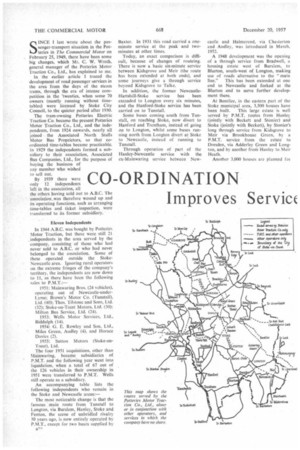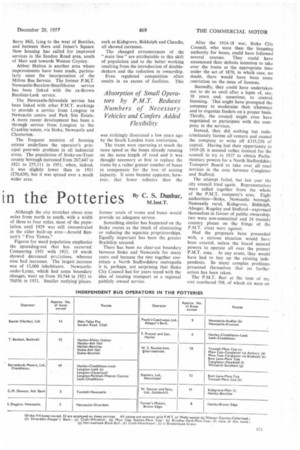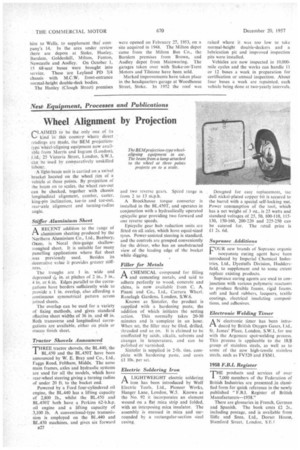CO-ORDINATION Improves Service
Page 54

Page 55

Page 56

If you've noticed an error in this article please click here to report it so we can fix it.
• By C • C. S. Dunbar, al the Potteries M.Inst.T. SINCE I last wrote about the passenger-transport situation in the Potteries in The Commercial Motor on February 25, 1949, there have been some big changes, which Mr. C. W. Wroth, general manager of the Potteries Motor Traction Co., Ltd., has explained to me.
In the earlier article I traced the development of road passenger services in the area from the days of the steam trams, through the era of intense competition in the 'twenties, when some 70 owners (mostly running without timetables) were licensed by Stoke City Council, to the quieter period after 1930.
The tram-owning Potteries Electric Traction Co. became the present Potteries Motor Traction Co., Ltd., and the independents, from 1924 onwards, nearly all joined the Associated North Staffs Motor Bus Proprietors, so that coordinated time-tables became practicable. In 1929 the independents formed a subsidiary to their association, Associated Bus Companies, Ltd., for the purpose of buying the business of any member who wished to sell out.
By 1939 there were only 12 independents left in the association, all the others having sold out to A.B.C. The association was therefore wound up and its operating functions, such as arranging time-tables and ticket inspection, were transferred to its former subsidiary.
Eleven Independents In 1944 A.B.C. was bought by Potteries Motor Traction, but there were still 21 independents in the area served by the company, consisting of those who had never sold to A.B.C. or who had never belonged to the association. Some of these operated outside the StokeNewcastle area. Ignoring rural operators on the extreme fringes of the company's territory, the independents are now down to 11, as there have been the following sales to P.M.T.: 1951: Mainwaring Bros. (24 vehicles), operating out of Newcastle-underLyme; Brown's Motor Co. (Tunstall), Ltd. (40): Thos. Tilstone and Sons, Ltd. (32); Stoke-on-Trent Motors, Ltd. (30); Milton Bus Service, Ltd. (24).
1953: Wells Motor Services, Ltd., Biddulph (14).
1954: G. E. Rowley and Son, Ltd., Miles Green, Audley (4), and Horace Davies (2).
1955: Sutton Motors (Stoke-onTrent), Ltd.
The four 1951 acquisitions, other than Mainwaring, became subsidiaries of P.M.T. and the following year went into liquidation, when a total of 67 out of the 126 vehicles in their ownership in 1951 were transferred to P.M.T. Wells still operate as a subsidiary.
An accompanying table lists the following independents who remain in the Stoke and Newcastle areas:—
The most noticeable change is that the famous main route from Tunstall to Langton, via Burslem, Hanley, Stoke and Fenton, the scene of unbridled rivalry 30 years ago, is now entirely operated by P.M.T., except for two buses supplied by Baxter. In 1931 this road carried a oneminute service at the peak and twominutes at other times.
Today, an exact comparison is difficult, because of changes of routeing. There is now a basic six-minute service between Kidsgrove and Meir (the route has been extended at both ends), and some journeys give a through service beyond Kidsgrove to Talke.
In addition, the former NewcastleHartshill-Stoke service has been extended to Longton every six minutes, and the Hanford-Stoke service has been carried on to Tunstall.
Some buses coming south from Tunstall, on reaching Stoke, now divert to Hanford and Trentham, instead of going on to Longton, whilst some buses running north from Longton divert at Stoke to Newcastle, instead of running to Tun stal I.
Through operation of part of the Hanley-Newcastle service with the ex-Mainwaring service between New
castle and Halmerend, via Chesterton and Audley, was introduced in March, 1952.
A 1948 development was the opening of a through service from BradwcII, a housing estate west of Bursletn, to Blurton, south-west of Longton, making use of roads alternative to the " main line." This has been extended at one end to Newcastle and forked at the Blurton end to serve further development there.
At Bentilee, in the eastern part of the Stoke municipal area, 3,500 houses have been built. This large estate is well served by P.M.T. routes from Hanley (jointly with Beckett and Stonier) and Stoke (jointly with Beckett), by Stonier's long through service from Kidsgrove to Meir via Brookhouse Green, by a P.M.T. service from the estate to Dresden, via Adderley Green and Longton, and by another from Hanley to.Meir Heath.
Another 3,000 houses are planned for Berry Hill, lying to the west of Bentilee, and between there and Joiner's Square. New housing has called for improved services in the Sandon Road area, south of Meir and towards Weston Coyney.
Abbey Hu1ton is another area whore improvements have been made, particularly since the incorporation of the Milton Bus Service. The former P.M.T. Newcastle-B urslem-Smallth orne service has been linked with the ex-Brown Burslem-Leek service.
The Newcastle-Silverdale service has been linked with other P.M.T. workings to provide a service from Longton to Newcastle centre and Park Site Estate. A more recent development has been a through service from Longton to the Crackley=estate, via Stoke, Newcastle and Chesterton.
The frequent mention of housing estates underlines the operator's principal post-war problem in all industrial areas. The population of Stoke-on-Trent county borough increased from 267,647 in 1921 to 275,111 in 1951, when, indeed, it was slightly lower than in 1931 (276,639), but it was spread over a much wider area.
Although the city stretches about nine miles from north to south, with a width of three to four miles, most of the population until 1939 was still concentrated in the older built-up area—Arnold Bennett's "Five Towns."
Figures for ward population emphasize the spreading-out that has occurred. Comparing 1951 with 1931, 19 wards showed decreased peulations, whereas nine had increases. The largest increase was of 13,000 inhabitants. Newcastleunder-Lyme, which had some boundary changes, went up from 50,744 in 1921 to 70036 in 1951. Smaller outlying places. such as Kidsgrove, Biddulph and Cheadle, all showed increases.
The changed circumstances of the " main line" are attributable to this shift of population and to the better working resulting from the introduction of doubledeckers and the reduction in ownership.
Even regulated competition often results in an excess of facilities. This was strikingly illustrated a few years ago by the South London tram conversion.
The trams were operating at much the same speed as the buses already running on the same length of road and it was thought necessary at first to replace the trams by a rather greater number of buses to compensate for the loss of seating capacity. It soon became apparent, however, that fewer vehicles than the former totals of trams and buses would provide an adequate service.
Something similar has happened on the Stoke routes as the result of eliminating or reducing the separate proprietorships. Equally important has been the greater flexibility secured.
There has been no clear-cut boundary between Stoke and Newcastle for many years and because the two together constitute a North Staffordshire metropolis it is, perhaps, not surprising that Stoke City Council has for years toyed with the idea of treating transport as a regional publicly owned service.
After the 1914-18 war, Stoke City Council, who were then the licensing authority for buses, could have followed several courses. They could have announced their definite intention to take over the trams at the appropriate time under the act of 1870, in which case, no doubt, there would have been some restriction on the issue of licences.
Secondly, they could have undertaken not to do so until after a lapse of, say, 30 years and, meantime, to control licensing. This might have prompted the company to modernize their trimways and to organize feeders on a proper basis. Thirdly, the council might even have negotiated to participate with the company in the services.
Instead, they didnothing but indiscriminately license all corners and caused the company to write off £335,250 of capital. Having lost their opportunity in 1919-20, it seemed rather ironical for the council to try in 1937 to obtain Parliamentary powers for a North Staffordshire Transport Board to take over all toad services in the area between Congleton and Stafford.
The attempt failed, but last year the city council tried again. Representatives were called together from the whole of the P.M.T. company's area. Eight authorities—Stoke, Newcastle borough, Newcastle rural, Kidsgrove, Biddulph, Alsager, Rugeley and Stafford—expressed themselves in favour of public ownership. two were non-committal and 24 (mainly country places on the fringe of the P.M.T. area) were against.
Had the proposals been proceeded with, a curious situation would have been created, unless the board secured powers to operate all over the present P.M.T. area. In any event, they would have had to buy up the existing independents. So many complex problems presented themselves that no further action has been taken.
The P.M.T. fleet at the time of visit numbered 508, of which six were on hire to Wells, to supplement that" corn. pany's 14. In the area under review there are depots at Stoke, Hanley, Barslem. GoldenhilI, Milton, Fenton, Newcastle and Auelley. On October 1, I. 68-seat buses were brought into service. These are Leyland PD 3/4 chassis with M.C.W. front-entrance normal-height double-deck bodies. The Hanley (Clough Street) premises were opened on February 27, 1953, on a site acquired in 1948. The Milton depot came from the Milton Bus Co., the Burslern premises from Brown, and Audley depot from Mainwaring. The garages taken over with Stoke-on-Trent Motors and Tilstone have been, sold.
Marked improvements have taken place in the headquarters garage at Woodhouse Street, Stoke. In 1952 the roof was raised where it was too low to take normal-height double-deckers and a lubrication pit and improved inspection pits were installed.
Vehicles are now inspected in 10.000mite cycles and the works can handle 11 or 12 buses a week in preparation for certification or annual inspection. About four buses a week are repainted, each vehicle being done at two-yearly intervals.




























































































